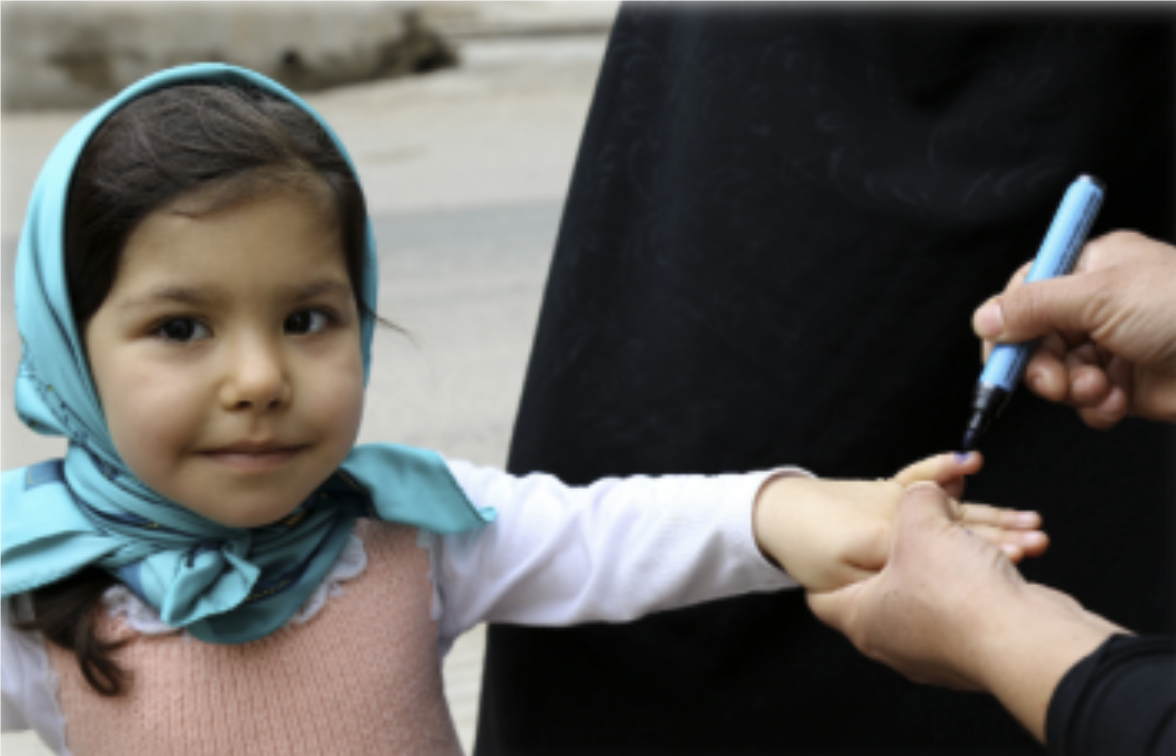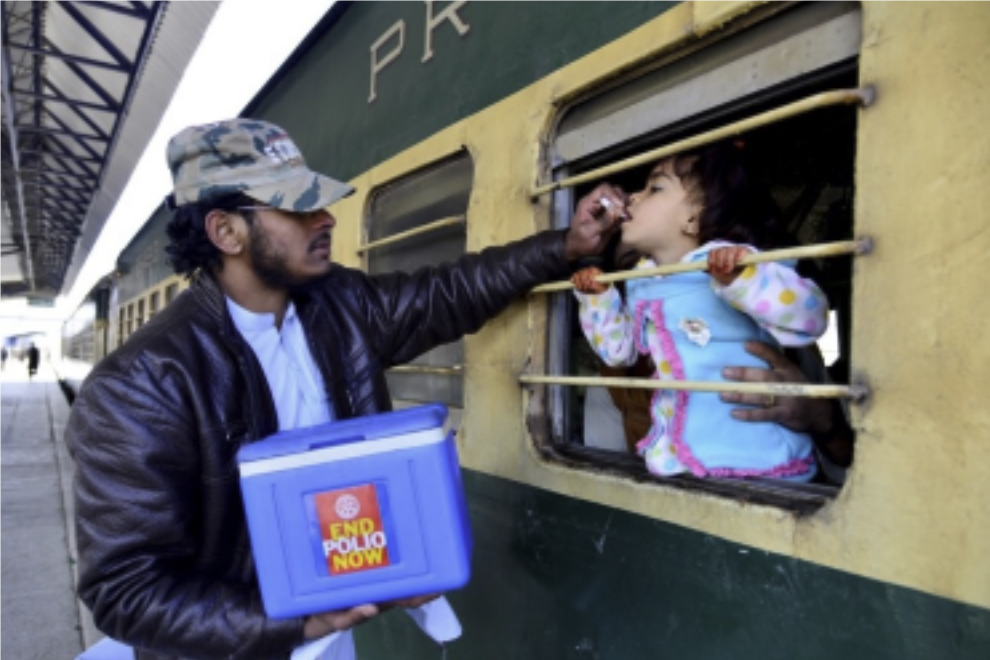
"The world has beaten back this disease significantly, but we must redouble efforts," - RI President Jennifer Jones, Global Citizens Festival 9/24/2022
Wild polioviruses are naturally occurring microorganisms circulated in the community through contaminated food or water.
• Crippling and potentially deadly, but rare
• Primarily Children
• Preventable but not curable
• Humans are the only host
CALENDAR YEAR TO DATE: 0
TOTAL FOR 2022: 30
TOTAL FOR 2021: 6
TOTAL FOR 2019: 140
“You never have an idea of what you might accomplish. All you do is pursue a question and see where it leads.” - Jonas Salk
 Circulating vaccine derived polio virus(cvdpv)
Circulating vaccine derived polio virus(cvdpv)The oral polio vaccine (OPV), a live, but weakened virus provides immunity in the gut where polio replicates. The vaccine virus is excreted in the stool, and in communities with low quality sanitation, this means that it can spread from person to person and help protect the community. However, in communities with low immunization rates, as the virus is spread from one unvaccinated child to another over a long period of time it can mutate and take on a form that can cause paralysis just like the wild polio virus.
- CALENDAR YEAR TO DATE: 0
- TOTAL FOR 2022: 614
- TOTAL FOR 2021: 578

Vaccine-derived polio is extremely rare. Since 2000, more than 10 billion doses of OPV have been given to nearly three billion children worldwide, and just over 1,000 cases of vaccine derived polio paralysis have been reported during that period.
Before the introduction of vaccines, polio killed or paralyzed more than half a million people worldwide every year. Since the late 1980s, cases have fallen by 99.9%, due to global efforts to immunize children with the oral polio vaccine. However, in communities with low vaccination coverage, the weakened polioviruses in this type of vaccine can – in rare cases – undergo changes that can threaten people’s health.
Polio spreads from person to person through contact with feces, often as a result of poor hand hygiene or consuming food or water contaminated with human feces. The virus initially replicates in the nose or throat, before moving to the intestines and multiplying, then entering the bloodstream and invading the central nervous system, where it can cause nerve damage and paralysis. Around one in 200 people who contract the disease will suffer paralysis; between five and ten percent of people who develop paralysis die because their breathing muscles stop working.
Fortunately, vaccines are highly effective at preventing polio. There are two types: The first is oral polio vaccine (OPV). It contains a mixture of poliovirus strains that have been weakened, meaning they can still replicate, but are not strong enough to cause paralysis. Because OPV is given via the mouth, it triggers the production of antibodies in both the intestines and the blood. This means that if a vaccinated person is exposed to wild poliovirus in the future, the virus won’t be able to replicate and infect other people.
The other type of vaccine is inactivated polio vaccine (IPV). It is produced from polioviruses that have been killed, so they cannot replicate, and is injected into the leg or arm. Although it is very good at triggering antibodies in the blood, preventing the virus from traveling to the nerves and causing paralysis, IPV is less effective at triggering antibodies in the intestines. This means that vaccinated people can still become infected with wild poliovirus and transmit it to other people, even though they don’t become ill themselves.
 Historically, OPV has been more popular than IPV because it is cheaper and easier to administer, allowing large numbers of children to be vaccinated. It also protects both the individual and the community against infection – unlike IPV, which only protects the individual – which is important if poliovirus is to be eradicated. However, too much transmission of this weakened virus can be problematic. In communities where lots of people have been vaccinated against polio, onward transmission is limited, and the virus quickly dies out. But in communities with low vaccine coverage, this weakened virus may continue to circulate for many months, gradually accumulating mutations that enable it to cause paralysis once more. It also only emerges in under-immunized communities, which is one reason why vaccinating every child is so important: If communities are fully immunized, this helps prevent the spread of both wild and vaccine-derived polio.
Historically, OPV has been more popular than IPV because it is cheaper and easier to administer, allowing large numbers of children to be vaccinated. It also protects both the individual and the community against infection – unlike IPV, which only protects the individual – which is important if poliovirus is to be eradicated. However, too much transmission of this weakened virus can be problematic. In communities where lots of people have been vaccinated against polio, onward transmission is limited, and the virus quickly dies out. But in communities with low vaccine coverage, this weakened virus may continue to circulate for many months, gradually accumulating mutations that enable it to cause paralysis once more. It also only emerges in under-immunized communities, which is one reason why vaccinating every child is so important: If communities are fully immunized, this helps prevent the spread of both wild and vaccine-derived polio.Around 350 permanent transit points have been set up along border areas of Afghanistan to vaccinate children on the move. They operate year-round and provide millions of doses of vaccine to children who are away from home.
New York is not out of the woods yet.
U.S. Centers for Disease Control (CDC) confirmed the presence of the poliovirus in a total of 94 positive wastewater samples collected in New York in October.
Of the 94 positive samples, 87 were genetically linked to the Rockland County resident confirmed with polio last summer. The other 7 samples were collected from wastewater in New York City and Orange County.
The New York State Department of Health (NYSDOH) points out that these polioviruses could cause illness, including paralysis, if they were to infect an unvaccinated individual. However, that since these samples came from wastewater (sewage samples), they have not contaminated drinking water (tap water), streams or lakes.
There had been no positive samples for polio reported since November 4 until in the January 6, 2023, report from the NYSDOH when there was one positive sample reported in Orange County.
 Message From Aiden O’Leary,
Message From Aiden O’Leary, Director of Polio at the World Health Organization
As 2022 draws to a close, I wanted to thank each and every one of you for the incredible work and contributions you have made to the global effort to eradicate polio once and for all. You are all far too many to name individually, so I would ask you to share this note with all of your own respective networks to pass on my gratitude.
2022, I believe, will go down as a year of ‘contrasts’, in the global effort to eradicate polio. On the one hand, we saw polio re-emerge in places such as New York and London, in south-east Africa, and an increase in new cases in Pakistan. But on the other hand, 2022 saw perhaps some of the most significant and important progress that we have ever seen and this is setting up the global effort for a unique opportunity for success in 2023.
While detection of polio from anywhere that it had previously been gone is of course a setback, the reality is that events such as New York and London, and indeed elsewhere, are being appropriately managed. We must focus our eye clearly on those areas which hold the key to a polio-free world, namely in the endemics and consequential geographies. And here the news is actually really encouraging.
In Pakistan, notwithstanding the increase in new cases, the outbreak is geographically confined, thanks to concerted emergency efforts led by the government and supported by partners. All cases are concentrated in just six districts of one province, out of a total of 180 districts in the country. And while virus has been detected outside of these areas it has not succeeded in re-establishing a foothold outside the core endemic zone. In 2020, the country was affected by 11 separate and individual chains of transmission. This was reduced to four in 2021, and in 2022, only a single chain remains. It means individual virus lines are being successfully knocked out. It means the approaches being implemented in the country are working.
In Afghanistan too, an epidemiological deep-dive reveals an encouraging picture. Just over twelve months on from the political and security transition in country, access to all children continues to improve, including more than 3.5 million children who had not been reached for almost five years, albeit against a tragic backdrop of a severe and acute humanitarian crisis. Out of the country’s 34 provinces, just two remain active with endemic transmission. And where Afghanistan was once affected by eight separate transmission chains, in 2022 there now remains just two.
Such epidemiological and virological progress is similar to what epidemiologists observed during the ‘end game’ efforts in other previous global polio reservoirs,
notably Nigeria, India and Egypt, all giving hope that these remaining two endemic countries are on the right track.
“Every child is a gift of Allah, and every child in Pakistan, to me, is like my own child, so I will do my best to take the message to every doorstep in Pakistan.
Reaching every child, every time with the polio vaccine is not only necessary, but it is our duty. This disease
can't deter us; we will defeat it.” - Shahid Afridi
In terms of cVDPV outbreaks, almost 90 percent of the disease burden is in three sub-national geographic areas, namely eastern DR Congo, northern Yemen and northern Nigeria. These areas also overlap with some of the highest proportion of ‘zero dose’ children, ie those children who are either un- or under- vaccinated. The situation in northern Nigeria is particularly encouraging: having seeded outbreaks in more than 19 countries, Nigeria accounted for two-thirds of all global cases in 2021. In the second half of 2022, however, we have seen a dramatic decrease in new cases, with only nine reported during that time. And although the outbreaks in Yemen and DR Congo continue to expand, there is a clear plan for early 2023 to urgently address these respective situations. The new nOPV2, a key tool in this fight, continues to be rolled-out at an accelerated pace, with more than 530 million doses now administered.
This brings us of course to the WPV outbreak in south-east Africa. Following detection of the outbreak in February, a series of multi-country outbreak response campaigns were immediately launched, in five countries of the subregion, to urgently stop this outbreak. This effort is ongoing, and quality of outbreak response continues to improve from campaign to campaign. And as the case in the other ‘most consequential geographies’, the focus is entirely on reaching zero-dose children, by concentrating technical capacity and support on those areas with the highest proportion of under-reached children and communities. No WPV1 detection have been recorded outside a single province in northern Mozambique in 2022. We are not yet at the end but momentum continues to be sustained and this is extremely encouraging.
2022 was of course the first year of the new GPEI Strategy - Delivering on a Promise and this very much takes the COVID-19 reality into account. In addition to adapting our polio operations, cross-programmatic integration has been accelerated by the COVID-19 pandemic. Polio staff across the world continue to contribute to the COVID-19 response and immunization recovery efforts, together with the introduction and administration of COVID-19 vaccines, as highlighted in this report. This provides clear evidence of the broader value of the polio network and its work to align its priorities with broader public health efforts, notably global vaccine and immunization strategies. It also speaks to the importance of effectively transitioning this infrastructure, to ensure that it will continue to benefit broader public health, emergencies and pandemic response efforts, long after the disease is gone.
ONE HUNDRED THIRTY TWO
The number of days since the last case of WPV1 occurred in Pakistan (September 15th, 2022).
ONE HUNDRED FORTY EIGHT
The number of days since the last case of WPV occurred in Afghanistan (August 10, 2022)
As 2022 draws to a close, the program is on a strong epidemiological, operational and virological footing. We are absolutely on the right track, and this realization should motivate all partners and stakeholders into overdrive. Throughout 2022, we saw tremendous displays of global support, ranging from the World Health Assembly, to the Rotary International Convention in Houston, USA, to the G7 and G20. Perhaps the most significant signal of support came at the global GPEI Pledging Moment at the World Health Summit in October 2022, in Berlin, Germany, co-hosted by the Government of Germany, where global leaders pledged an incredible US$2.6 billion to the effort. As 2022 draws to a close, we have also received very positive signals of support from the UK and the EU/EIB.
Challenges remain ahead. Zero-dose children have to be reached in the most consequential geographies. Remaining financial resources to achieve success have to be mobilized. But in spite of initial appearances, 2022 put the world on a strong footing for success in 2023. And of course, that is the target clearly listed in the GPEI Strategy 2022-2026: to interrupt all remaining virus transmission by end-2023 and to achieve global certification by no later than end-2026.
There is a clear momentum as the year draws to a close, that must be carried into 2023 for a final concerted push. Success is in our hands. And all of you have brought us here: thanks to your individual efforts, you have brought the world on the threshold of being polio-free. Your efforts have saved children from lifelong paralysis, have saved lives. On behalf of the GPEI, all I can say is: Thank you for all you have done for polio eradication! If we all redouble our efforts one final time, I am sure we will make it in 2023.
Allow me to finish with a quote by our fellow polio eradicator, friend and GPEI vaccinator Sadiya from Kano, Nigeria, who addressed the Pledging Event in Berlin by video. She told the gathering: “Together, we can end polio in the world. I will try my best. I hope you will too.” Let us follow Sadiya’s example, let us do our best as well. Together, let us end polio.
Norb Murray
Rotary Club of Boise SW
District 5400 PolioPlus Chair 2022-2023
norbmurray1942@gmail.com
208-370-5050